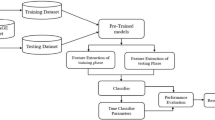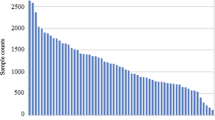Abstract
Nowadays, deep learning is one of the popular research areas of the computer sciences, and many deep networks have been proposed to solve artificial intelligence and machine learning problems. Residual networks (ResNet) for instance ResNet18, ResNet50 and ResNet101 are widely used deep network in the literature. In this paper, a novel ResNet-based signal recognition method is presented. In this study, ResNet18, ResNet50 and ResNet101 are utilized as feature extractor and each network extracts 1000 features. The extracted features are concatenated, and 3000 features are obtained. In the feature selection phase, 1000 most discriminative features are selected using ReliefF, and these selected features are used as input for the third-degree polynomial (cubic) activation-based support vector machine. The proposed method achieved 99.96% and 99.61% classification accuracy rates for gender and activity recognitions, respectively. These results clearly demonstrate that the proposed pre-trained ensemble ResNet-based method achieved high success rate for sensors signals.








Similar content being viewed by others
References
Munoz-Organero M (2019) Outlier detection in wearable sensor data for human activity recognition (HAR) based on DRNNs. IEEE Access 7:74422–74436
Chen Y, Shen C (2017) Performance analysis of smartphone-sensor behavior for human activity recognition. IEEE Access 5:3095–3110
Wang K, He J, Zhang L (2019) Attention-based convolutional neural network for weakly labeled human activities recognition with wearable sensors. IEEE Sens J 19:7598–7604
Cornacchia M, Ozcan K, Zheng Y, Velipasalar S (2016) A survey on activity detection and classification using wearable sensors. IEEE Sens J 17(2):386–403
Wang J, Chen Y, Hao S, Peng X, Hu L (2019) Deep learning for sensor-based activity recognition: a survey. Pattern Recognit Lett 119:3–11
Altun K, Barshan B, Tunçel O (2010) Comparative study on classifying human activities with miniature inertial and magnetic sensors. Pattern Recognit 43(10):3605–3620
Song B, Kamal AT, Soto C, Ding C, Farrell JA, Roy-Chowdhury AK (2010) Tracking and activity recognition through consensus in distributed camera networks. IEEE Trans Image Process 19(10):2564–2579
Huynh-The T et al (2018) Hierarchical topic modeling with pose-transition feature for action recognition using 3D skeleton data. Inf Sci 444:20–35
Mario M-O (2018) Human activity recognition based on single sensor square HV acceleration images and convolutional neural networks. IEEE Sens J 19(4):1487–1498
Tian Y, Wang X, Chen L, Liu Z (2019) Wearable sensor-based human activity recognition via two-layer diversity-enhanced multiclassifier recognition method. Sensors 19(9):2039
Jiang W, Yin Z (2013) Human activity recognition using wearable sensors by deep convolutional neural networks. In: Proceedings of the 23rd ACM International Conference on Multimedia, ACM, pp 1307–1310
Chernbumroong S, Cang S, Atkins A, Yu H (2013) Elderly activities recognition and classification for applications in assisted living. Expert Syst Appl 40(5):1662–1674
Nweke HF, Teh YW, Al-Garadi MA, Alo UR (2018) Deep learning algorithms for human activity recognition using mobile and wearable sensor networks: state of the art and research challenges. Expert Syst Appl 105:233–261
Wang Z, Guo M, Zhao C (2016) Badminton stroke recognition based on body sensor networks. IEEE Transa Hum Mach Syst 46(5):769–775
Gravina R, Alinia P, Ghasemzadeh H, Fortino G (2017) Multi-sensor fusion in body sensor networks: state-of-the-art and research challenges. Inf Fusion 35:68–80
Cheng W-C, Jhan D-M (2012) Triaxial accelerometer-based fall detection method using a self-constructing cascade-AdaBoost-SVM classifier. IEEE J Biomed Health Inf 17(2):411–419
Margarito J, Helaoui R, Bianchi AM, Sartor F, Bonomi AG (2015) User-independent recognition of sports activities from a single wrist-worn accelerometer: a template-matching-based approach. IEEE Trans Biomed Eng 63(4):788–796
Wang A, Chen G, Yang J, Zhao S, Chang C-Y (2016) A comparative study on human activity recognition using inertial sensors in a smartphone. IEEE Sens J 16(11):4566–4578
He K, Zhang X, Ren S, Sun J (2016) Deep residual learning for image recognition. In: Proceedings of the IEEE Conference on Computer Vision and Pattern Recognition, pp 770–778
LeCun Y, Bengio Y, Hinton G (2015) Deep learning. Nature 521(7553):436
Goodfellow I, Bengio Y, Courville A (2016) Deep learning. MIT Press, Cambridge
Sutskever I, Martens J, Dahl G, Hinton G (2013) On the importance of initialization and momentum in deep learning. In: International Conference on Machine Learning, pp 1139–1147
Hinton GE, Osindero S, Teh Y-W (2006) A fast learning algorithm for deep belief nets. Neural Comput 18(7):1527–1554
Bengio Y, Goodfellow I, Courville A (2017) Deep learning. Citeseer, Princeton
Oh J, Guo X, Lee H, Lewis RL, Singh S (2015) Action-conditional video prediction using deep networks in atari games. In: Advances in Neural Information Processing Systems, pp 2863–2871
Abdel-Hamid O, Mohamed A-R, Jiang H, Deng L, Penn G, Yu D (2014) Convolutional neural networks for speech recognition. IEEE/ACM Trans Audio Speech Lang Process 22(10):1533–1545
Cao W, Wang X, Ming Z, Gao J (2018) A review on neural networks with random weights. Neurocomputing 275:278–287
Salakhutdinov R, Mnih A, Hinton G (2007) Restricted Boltzmann machines for collaborative filtering. In: Proceedings of the 24th International Conference on Machine Learning, ACM, pp 791–798
Le Roux N, Bengio Y (2008) Representational power of restricted Boltzmann machines and deep belief networks. Neural Comput 20(6):1631–1649
LeCun Y, Bottou L, Bengio Y, Haffner P (1998) Gradient-based learning applied to document recognition. Proc IEEE 86(11):2278–2324
Szegedy C et al (2015) Going deeper with convolutions. In: Proceedings of the IEEE Conference on Computer Vision and Pattern Recognition, pp 1–9
Iandola FN, Han S, Moskewicz MW, Ashraf K, Dally WJ, Keutzer K (2016) SqueezeNet: AlexNet-level accuracy with 50x fewer parameters and < 0.5 MB model size. arXiv preprint arXiv:1602.07360
Simonyan K, Zisserman A (2014) Very deep convolutional networks for large-scale image recognition. arXiv preprint arXiv:1409.1556
Xsens N (2010) MTi and MTx user manual and technical documentation
Barshan B, Yüksek MC (2014) Recognizing daily and sports activities in two open source machine learning environments using body-worn sensor units. Comput J 57(11):1649–1667
Robnik-Šikonja M, Kononenko I (2003) Theoretical and empirical analysis of ReliefF and RReliefF. Mach Learn 53(1–2):23–69
Kononenko I, Šimec E, Robnik-Šikonja M (1997) Overcoming the myopia of inductive learning algorithms with RELIEFF. Appl Intell 7(1):39–55
Rowland R et al (2019) A simple burn wound severity assessment classifier based on spatial frequency domain imaging (SFDI) and machine learning. In: Photonics in Dermatology and Plastic Surgery 2019, 2019, vol. 10851: International Society for Optics and Photonics, p 1085109
Liapis A, Katsanos C, Sotiropoulos D, Xenos M, Karousos N (2015) Recognizing emotions in human computer interaction: studying stress using skin conductance. In: IFIP Conference on Human–Computer Interaction. Springer, pp 255–262
Hu C, Chen Y, Hu L, Peng X (2018) A novel random forests based class incremental learning method for activity recognition. Pattern Recognit 78:277–290
Hammad I, El-Sankary K (2019) Practical considerations for accuracy evaluation in sensor-based machine learning and deep learning. Sensors 19(16):3491
Wang L, Liu R (2019) Human activity recognition based on wearable sensor using hierarchical deep LSTM networks. Circuits Syst Signal Process 39:837–856
Kuncan F, Kaya Y, Kuncan M (2019) New approaches based on local binary patterns for gender identification from sensor signals. J Faculty Eng Architect Gazi Univ 34(4):2173–2185
Vavoulas G, Chatzaki C, Malliotakis T, Pediaditis M, Tsiknakis M (2016) The MobiAct dataset: recognition of activities of daily living using smartphones. In: ICT4AgeingWell, pp 143–151
Ferrari A, Mobilio M, Micucci D, Napoletano P (2019) On the homogenization of heterogeneous inertial-based databases for human activity recognition. In: 2019 IEEE World Congress on Services (SERVICES), vol. 2642. IEEE, pp 295–300
Chen Y, Zhong K, Zhang J, Sun Q, Zhao X (2016) LSTM networks for mobile human activity recognition. In: 2016 International Conference on Artificial Intelligence: Technologies and Applications. Atlantis Press
Ajerla D, Mahfuz S, Zulkernine F (2019) A real-time patient monitoring framework for fall detection. Wirel Commun Mob Comput. https://doi.org/10.1155/2019/9507938
Ferrari A, Micucci D, Mobilio M, Napoletano P (2019) Hand-crafted features vs residual networks for human activities recognition using accelerometer. In: 2019 IEEE 23rd International Symposium on Consumer Technologies (ISCT). IEEE, pp 153–156
Welhenge AM, Taparugssanagorn A (2019) Human activity classification using long short-term memory network. SIViP 13(4):651–656
Author information
Authors and Affiliations
Corresponding author
Additional information
Publisher's Note
Springer Nature remains neutral with regard to jurisdictional claims in published maps and institutional affiliations.
Rights and permissions
About this article
Cite this article
Tuncer, T., Ertam, F., Dogan, S. et al. Ensemble residual network-based gender and activity recognition method with signals. J Supercomput 76, 2119–2138 (2020). https://doi.org/10.1007/s11227-020-03205-1
Published:
Issue Date:
DOI: https://doi.org/10.1007/s11227-020-03205-1




